
The hickatee or in Spanish tortuga blanca, also called the Central American river turtle, is the only living species in the family Dermatemydidae. The species is found in the Atlantic drainages of Central America, specifically Belize, Guatemala, southern Mexico and probably Honduras. It is a relatively large-bodied species, with records of 60 cm (24 in) straight carapace length and weights of 22 kg (49 lb); although most individuals are smaller. This is a herbivorous and almost completely aquatic turtle that does not even surface to bask. Bizarrely for reptiles, the eggs can remain viable even after being underwater for weeks -in the recent past, some scientists mistakenly claimed it nests underwater, likely due to visiting Central America during a frequent flood, when nests are often submerged.

Dermochelyidae is a family of turtles which has seven extinct genera and one extant genus, including the largest living sea turtles.

Emys is a small genus within the family Emydidae. The genus, consisting primarily of freshwater pond turtles, is endemic to Europe and North America.

Macrochelys is a genus of very large freshwater turtles in the family Chelydridae, native to the Southeastern and Midwestern United States. Only a single extant species was recognized until 2014, when a study divided it into two, or possibly three species. These turtles are easily recognized by three distinct dorsal ridges with raised spikes.

Kinosternoidea is a superfamily of aquatic turtles, which includes two families: Dermatemydidae, and Kinosternidae.
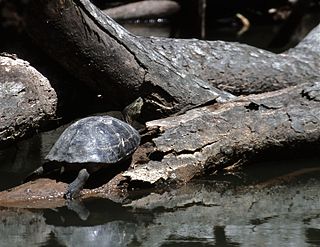
The yellow-headed temple turtle is a large species of turtle in the family Geoemydidae. The species is native to Southeast Asia.
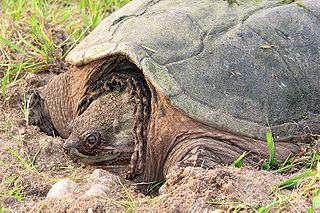
Chelydra is one of the two extant genera of the snapping turtle family, Chelydridae, the other being Macrochelys, the much larger alligator snapping turtle. The snapping turtles are native to the Americas, with Chelydra having three species, one in North America and two in Central America, one of which is also found in northwestern South America.

Testudinoidea is a superfamily within the suborder Cryptodira of the order Testudines. It includes the pond turtles, Asian turtles, the monotypic big-headed turtle, and the tortoises.
The Namoi River snapping turtle, also commonly known as Bell's turtle, the Namoi River elseya, or Bell's saw-shelled turtle, is a species of turtle in the family Chelidae. The species is endemic to New South Wales, Australia.
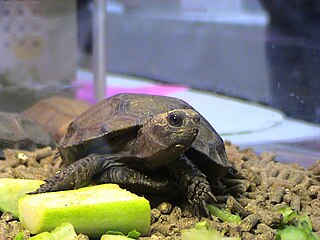
Manouria is a genus of tortoises in the family Testudinidae. The genus was erected by John Edward Gray in 1854.
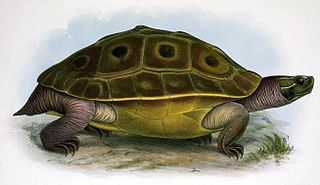
The Burmese eyed turtle, also known as the Bengal eyed terrapin, Burmese peacock turtle or swamp turtle, is a species of turtle in the family Geoemydidae of southern Asia.

The yellow-bellied mud turtle is a species of turtle in the family Pelomedusidae. It is found in Madagascar, Malawi, Mozambique, Seychelles, South Africa, and Tanzania.
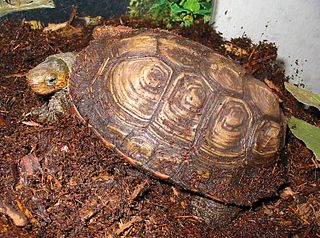
Rhinoclemmys is a genus of turtles in the family Geoemydidae, the only genus in the subfamily Rhinoclemmydinae. Member species of the genus are commonly known as the Neotropical wood turtles and are the only geoemydids known from the Americas. As such, they have adapted to a wide range of habitats, which is reflected in the species' common names.

The peninsula cooter is a species of freshwater turtle in the genus Pseudemys. It is sometimes considered a subspecies of the coastal plain cooter when that turtle is not itself considered a subspecies of the river cooter.
Kinosternon arizonense is an extinct species of mud turtle in the genus Kinosternon. Initially described by Charles W. Gilmore in 1922. In 2016 McCord examined available Pliocene material of K. arizonense and concluded that the fossil material differs significantly from the extant turtles. Joyce and Bourque (2016) concurred. Rhodin et al. (2017), listed Kinosternon arizonense as extinct.

Phrynops williamsi, also known commonly as Williams' side-necked turtle, Williams' South American sideneck turtle, William's [sic] South American side-necked turtle, William's [sic] toadhead turtle, and Williams' toadhead turtle, is a species of turtle in the family Chelidae. The species is endemic to South America.
The African keeled mud turtle is a species of turtle in the family Pelomedusidae. It is endemic to central Africa : the Democratic Republic of the Congo, the Republic of the Congo, and Gabon.
The Ivory Coast mud turtle is a species of turtle in the family Pelomedusidae. It is one of the most recently described turtle species.
The Pelusios cupulatta is typically found in riverine and wetland habitats mainly located in the southern Ivory Coast of West Africa. Endemic to the Upper Guinean forest region such as wetlands/rivers they are usually found primarily in forested banks as well as aquatic vegetation. Compared to other counterparts within its family, P. Cupulatta prefers an abundance of aquatic vegetation as its primary habitat. Despite this, Pelusios castaneus is a potential competitor due to similar habitats albeit different preferences regarding specific locations. Interspecific competition is able to regulate the coexistence of potential competitors but also niche expansion is available within the family when alone.
Comparative to other species at a local spatial level, Pelusios niger and Pelusios cupulatta both belong to larger size categories compared to others within the Pelusios records with the maximum male SCL being 31.3 and the maximum female SCL being 27.1. The two different turtle species are also allopatric, meaning that they are related but occur in separate non-overlapping geographical areas compared to the sympatric of P. castaneus. White P. castaneus intensely uses forested banks, P, and cupulatta aren't typically found in such areas as they aim for places with large amounts of aquatic vegetation. In presence of P. niger, P. cupulatta are usually found less than 10 km away showing how closely these two groups typically reside at roughly close locations.
The African dwarf mud turtle is a species of turtle in the family Pelomedusidae. It is endemic to Africa : in Angola, the Democratic Republic of the Congo, Malawi, and Zambia. These mud turtles are the smallest of all African turtle species, “Nanus” which they are referred to are one of the 3 smallest turtle species in the world. The other two are Stink Pot Musk and Muhlenberg's Bog Turtles. All 3 species barely reach 4 inches as full grown adults. Like many of the world's chelonians, Pelusios castaneus has the potential to live a long life. Reports typically suggest more than 50 years in captivity for this species.

Scott A. Thomson is an Australian herpetologist, paleontologist, and taxonomist, specialising in turtles of the family Chelidae.















